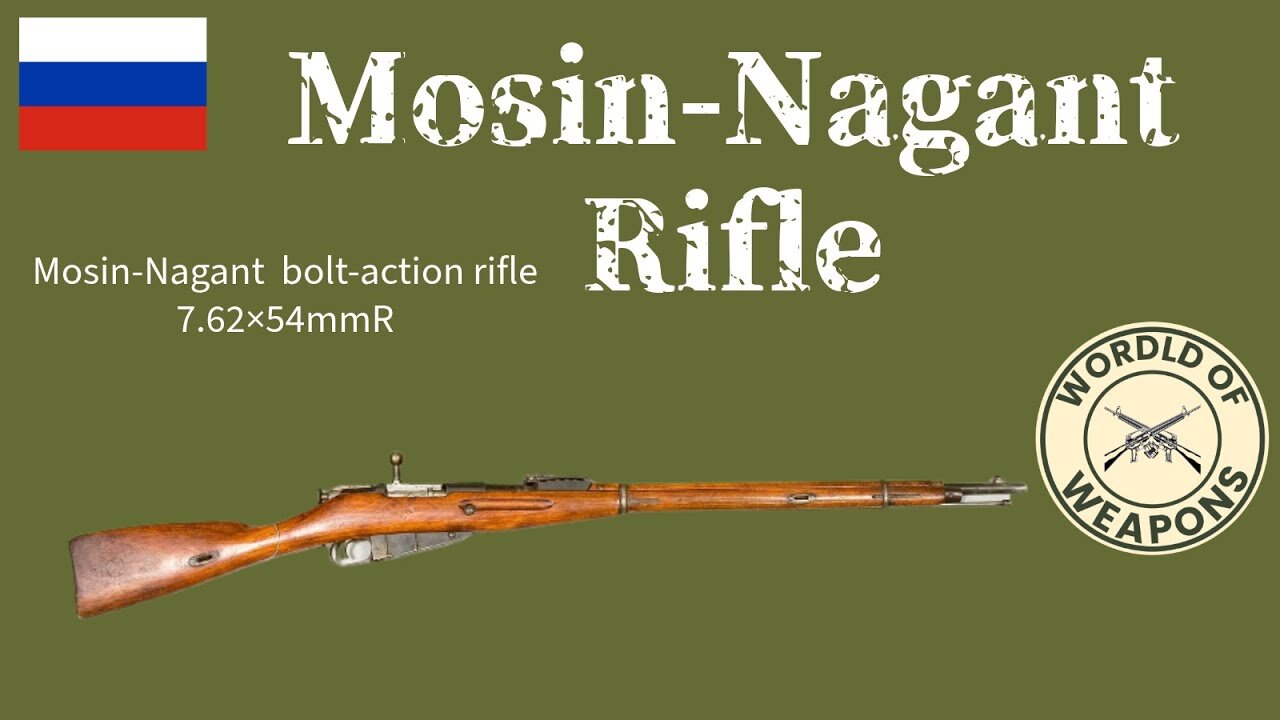Premium Only Content

Mosin Nagant Rifle 🇷🇺 A Legend of Military History
1.Introduction 00:00
2.Development 00:30
3.Technical details 02:47
The Mosin-Nagant Rifle, known in the Russia as “Vintovka Mosina” (Mosin Rifle), was developed under government commission in the late 1880’s and early 1890’s. It was officially adopted for service by the Russian Tsar in 1891 as “Trechlineynaja Vintovka Obraztsa 1891 Goda” (three-line rifle system 1891).
Development:
The development of the M1891 rifle is somewhat shady and controversial. During official trials, two designs were selected for the final round – one by the Russian Army captain Mosin, and another, by the Belgian designer Nagant. The selected design, adopted by the Commission, utilized features from both. Leon Nagant was paid for his part of the design with a very serious amount of money. Mosin received a rank promotion and worked at the Sestroretsk arsenal, trying to get this rifle ready for production. The exact amount of influence of each designer is still unclear.
Since the Russian arms industry was not ready to produce this rifle at the moment of its adoption, the first batches were purchased from the Chatelleraut Arms factory of France. Full-scale local production only began in 1894 – 1895 at two major Russian state arms factories, Izhevsk and Tula. Foreign contractors were used once again to manufacture this rifle in 1916 and 1917, during the First World War. Russia at that time was in desperate need for more rifles. Contracts were signed with two major American companies, Remington and Westinghouse, which manufactured large numbers of the improved pattern M1891/10 rifle.
Because of the upheaval and revolutions in 1917 most of these rifles were not delivered to the Russian government. Later they were used in the USA for training purposes, as well as being sold to civilians. Russian production of this rifle continued until 1948 or so, when the machinery to produce was sold to Poland.
The Mosin rifle in different variations was a standard military arm of the Russian and Red Army for some 60 years. It was also adopted and used by China, Finland, Hungary, Poland, North Korea among other countries. It is still a popular rifle in Russia and elsewhere as a civilian hunting rifle, due to relatively low prices and readily available ammunition.
Technical details:
The Mosin-Nagant rifle is a bolt operated, magazine fed rifle. It used an integral, single stack magazine, loaded from clip chargers, with the capacity for 5 rounds. The magazine protruded below the stock just ahead of the trigger guard. It had a hinged floorplate, used to unload the magazine all at once and to clean it.
Due to the single stack design and the lack of feed lips, a special device – second-round cutoff, was built into the magazine to avoid double feeds. On early pattern rifles this device also worked as an ejector, but since the M1891/30 model, a separate ejector was introduced. The rotating bolt featured dual frontal locking lugs that were located horizontally when the bolt was locked. The Mosin-nagant rifle is striker-fired. The striker was cocked when the bolt was opened. A safety was incorporated into the bolt which locked the striker. It was applied by pulling out and rotating a knurled cap at the rear of the bolt. To disengage the safety, reverse operation was required.
The bolt could be removed from the receiver without any tools, simply by pulling it open, then depressing the trigger and removing it. It could be further disassembled without any other tools and contained very few parts. Original spike shaped bayonets featured a rectangular cross-section and a point shaped as a flat screwdriver, so that it could also be used as a disassembly tool when removed from the gun. The bayonet was always carried in battle-ready position. Some late pattern bayonet mountings featured front sight protection hoods. All bayonets were attached directly to the barrel. Stocks were usually made from birch, except for American-made M1891/10 rifles, that featured walnut stocks and were thus slightly heavier.
Sniper rifles, based on the M1891/30, hand-picked for accuracy, were issued with scope mounts on the left side of the receiver and had the bolt handles bent down.
-
 LIVE
LIVE
RanchGirlPlays
4 hours ago🔴 Red Dead Redemption: Let's go help De Santa 🤠
228 watching -
 LIVE
LIVE
Man in America
11 hours agoWHAT?! Trump & the Fed are DISMANTLING the Global Banking Cartel!? w/ Tom Luongo
1,788 watching -
 LIVE
LIVE
HELMET FIRE
1 hour agoDEADROP IS BACK!
250 watching -
 LIVE
LIVE
I_Came_With_Fire_Podcast
6 hours agoLive Fire (No Exercise) with DAN NUNN!!!
300 watching -
 1:57:20
1:57:20
Glenn Greenwald
6 hours agoBiden's Escalation Of The War In Ukraine With Scott Horton; Lee Fang On The Junk Food Industry Sabotaging RFK Jr.'s Plans & The Gaetz Situation | SYSTEM UPDATE #371
61.4K48 -
 LIVE
LIVE
Toitle
1 hour agoLet's Game | TOITLE HEADS, POKE OUT | WE BE GRINDIN
215 watching -
 LIVE
LIVE
Pepkilla
2 hours agoBlack ops 6 camo grinding ~
278 watching -
 1:02:24
1:02:24
Havoc
4 hours agoSurprise Album Drops | Stuck Off the Realness Ep. 20
21.5K -
 LIVE
LIVE
hockeymancb77
2 hours ago $0.92 earned2nd Rumble Stream!!! Friday night gaming! Come chat! Join the 7th man! Be Kind!
385 watching -
 LIVE
LIVE
Mally_Mouse
4 hours agoLet's Play!! - Mario Party Jamboree
402 watching